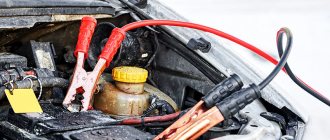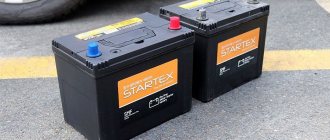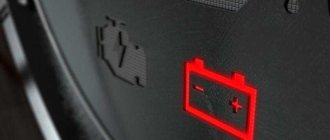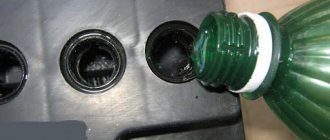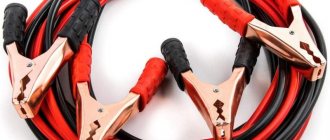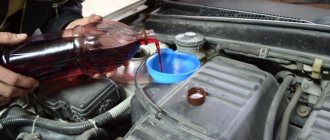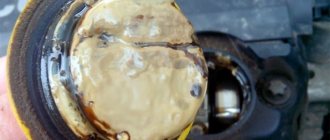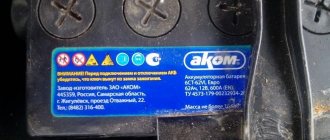Every driver must know the main signs of a dead car battery. There are quite a few reasons for this. The battery powers the starter, which starts the engine. The battery is charged from the generator, which turns on along with the engine. This explains the importance of keeping the battery charged.
The battery is also responsible for the operation of on-board electronics and electrics running when the engine is off. The list of related devices depends on the model and configuration of the car, but usually affects the dashboard, security, climate control, heated mirrors and windows, and a multimedia system. A dead battery will not only limit your vehicle's capabilities, but will also make it vulnerable to vandals and car thieves. Taking into account the situation, you need to figure out why the battery is discharged and what signs can be used to determine this.
What happens to the battery during low-charge operation?
If you do not keep track of when the battery starts to work on a low charge, the battery begins to significantly reduce the starting current during the process of starting the engine or receiving other unpleasant loads in this case. The higher the load, the higher the drawdown. And the higher the probability of breakdown of certain elements of the machine’s electronics becomes. Because instead of 12V, the equipment receives 8V or 7V from a discharged battery. The drawdown should not be below 10V. The processes inside the battery itself do not show anything pleasant:
- very rapid decomposition of lead plates, if we are talking about a classic acid battery for your car, contamination of the liquid during the process of decomposition of the material;
- a serious change in the properties of the liquid itself, which is caused by the ingress of materials unusual for it into the acid, a change in the conductivity of this material in the battery;
- a decrease in the ability to accept a charge, that is, the slow and steady death of the battery due to the extremely low quality of the internal environment, the complete collapse of many elements;
- a decrease in the electrolyte level due to its banal evaporation due to changed properties, the constant need to add distilled water or acid;
- inadequate response to turning on the charger, lack of the necessary indication due to completely changed properties of all elements of the internal environment.
This can happen with an acid battery if you do not charge it on time. When the battery is already discharged, the destruction process has begun. You should not allow the battery to be deeply discharged in this situation. This is a very unpleasant moment, which simply disables an expensive element of your car. So checking and recharging the battery is simply necessary. Especially if the car is mostly used in the city.
How to prevent discharge
To prevent the battery from presenting unpleasant surprises, it is, of course, necessary to monitor it. Here is a small list of simple activities that are worth doing:
- We periodically clean the battery itself from dirt, and its terminals from oxidation.
- At least once every 2-3 months we measure the voltage, if the on-board computer does not do this, once or twice a season we check the density of the electrolyte and its level (for serviced batteries).
- If necessary, we charge the battery with a stationary charger; under no circumstances leave the battery in a discharged state below 40% for a long time, especially in severe frost.
- During long-term parking (for example, in traffic jams), we turn off not particularly important consumers - a stereo system, air conditioning, etc.
- If there is a suspicion that the battery has begun to drain quickly, we measure the leakage current, which during parking should not exceed 50–80 mA. This is easy to do with a regular multimeter: the whole operation will take five minutes, but will help avoid serious problems and destruction of the battery.
- Before leaving the car, we check that all electrical appliances are turned off. Of course, most of the newest cars will warn the driver about the lights being turned on or the doors being open, but, firstly, not all cars can do this and not all equipment is controlled. Secondly, the same DRLs installed independently may not be seen by the on-board computer.
Well, of course, we replace the dying battery with a new one in a timely manner, without waiting until the old battery “dies” completely and gives out a surprise in the morning.
Key indicators of a discharged car battery
There are several indicators that indicate a malfunction of the electrical power supply in your car. Such indicators appear long before the real result of a discharged battery is visible. Learn to pay attention to these moments so as not to constantly find yourself in unpleasant situations. This will help you charge the battery on time and comply with all operating conditions of the car without any problems. So, the indicators could be the following:
- inadequate operation of the alarm, too long a reaction after pressing the button on the remote control key fob, poor door opening, jamming of the central locks;
- turning off the radio shortly after stopping the engine, this indicates a strong drop in voltage in the network due to the load on the battery;
- reduction in the quality of the headlights and the brightness of all lighting in the car - the lion's share of the generator's energy is sent to charge the depleted battery, there are problems with optics;
- when starting the engine, the first jerk of the starter is heard, then there is a second pause, then the starter spins again in normal mode, but the engine takes a long time to start;
- When warming up, the speed may fluctuate; these problems are caused by the fact that in this mode the engine may require a little energy from the battery, which is empty.
These are the unpleasant situations that indicate that your car has problems with the battery. Also, modern cars experience problems with the on-board computer, which begins to show problems in every possible way. There may be a firmware failure or problems with displaying the necessary data. The windshield and interior airflow does not work well due to lack of energy. All this indicates that the generator is actively trying to charge the battery, and it does not have time for your whims in the form of the climate in the cabin.
How to quickly start a car if the battery is dead
We talked about how to prevent unexpected battery discharge. But what should we do if we find ourselves in such a situation - we need to go urgently, but the battery is low? There are several answers here.
"From the pusher"
The simplest and most effective option. You can push with your hands, or you can ask someone to take you in tow. If, in addition to the driver, there are several passengers, then pushing with your hands will be realistic. It’s more difficult for one if there is no way to push downhill.
In the second example, of course, you will need a tow rope and a second car. There are usually no problems with the first one, but finding a second car, say, at 3 a.m. can be problematic.
Important! Both methods will only work on vehicles with a manual transmission. There is no point in pushing cars with an automatic transmission.
"Let's light a cigarette"
This method is suitable for starting a car from any gearbox, but you will need special cables, which, unlike a towing cable, are not found in every trunk.
In addition, you will need a second car with a working battery and an electrical capacity no less than ours. The startup algorithm using this method will look like this:
- We bring the recipient (a car with a working battery) close to the donor (a car with a dead battery).
- Turn off the ignition on both cars.
- Using cables, we connect the donor and recipient batteries, observing the polarity. We connect the positive terminal to the positive terminal, and the negative terminal to the negative terminal.
- We turn on the ignition on the recipient and start it.
- We set the recipient engine speed to about 1000 per minute. Disconnect the cables.
- We let the recipient work for 15–20 minutes so that the battery is at least slightly recharged from the generator.
- We move off carefully so as not to stall, and go about our business - the battery will receive the rest of its charge on the road.
- Upon arrival home, we check the condition of the battery and, if necessary, charge it.
We use a jump starter
To use this method, you do not need assistants, but you do need to have a jump starter or an autonomous starting device. Such a device is a compact lithium battery with an output voltage of 12 V. It, of course, costs money, but the purchase is worth it.
Starting a car with a discharged battery will not cause any difficulties, even in the dead of night and on a deserted road. We simply connect the jumper clamps to the terminals of our battery, turn on the device and start up. It is clear that for a successful start using this method, it is necessary that the battery of the jumper itself be pre-charged.
Important! The jump starter is only an assistant, not a full-fledged battery. If the battery of the car itself is completely discharged or is missing altogether, then the method will not work.
The most unpleasant consequences of a severely discharged battery
There are dozens of situations that occur when the battery is discharged. For example, the inability to start the engine, especially in the cold season. You can also remember the glitch of the on-board computer, which persistently produces errors and does not allow the engine to start or even does not allow the owner to enter the car. A common problem is also sticking starter contacts. This happens according to this scheme when the battery is discharged:
- the starter does not spin quickly, the process of starting this mechanism is unusually slow, which causes certain difficulties in the operation of the equipment itself for starting the unit;
- due to the slow start, a spark may pass between the contacts, which may well weld these contacts and power the starter directly from the battery without breaking the circuit;
- After this, the starter continues to turn constantly until you disconnect the battery terminal to interrupt the electrical circuit, which will cause certain problems;
- in the process of such rotation, it is possible to burn the starter itself, completely drain the battery until it is deeply discharged, as well as burn out the wires in this entire circuit;
- The biggest problem begins after stopping the engine, when the starter continues to spin directly from the battery and creates certain problems.
Of course, this situation is not common; it can only happen on cars that are not equipped with the highest quality electrical network devices. But the problem is that any car older than 5 years is not insured against such troubles. This is one type of trouble, but there can actually be a lot of such problems. It is worth insuring against them and promptly checking and changing the battery if it is too discharged.
Manual push method
It is one of the most common - of course, in urban areas or where there is a busy highway. To do this, the driver needs to turn on the speed, and several people will simply push the car from behind so that the wheels spin, and the engine itself starts due to the transmission.
Before assistants begin to push the car, the driver should engage (best!) reverse gear . As you know, its gear ratio is higher than the others. The road surface should be as hard as possible and not slip - in this case, the car will start faster.
Next , turn on the ignition, try to squeeze the clutch properly and give the assistants the command to push the car. As soon as the speed is gained, the clutch must be released and, if the tire grip is sufficient, the crankshaft will begin to move with the help of the transmission. When you understand and hear that the engine is working properly, squeeze the clutch again and give the gas to stabilize the engine.
Despite the effectiveness of this good old method, it will not work in winter on slippery roads . If the surface is smooth and slippery, the traction of the wheels will be very low. This means that the engaged gear will simply work “idle”.
However, if you tow the car with a cable and another vehicle, the method may still work. But not always: most likely, you will need to drag a stalled car along an icy road for a very long time in order for its wheels to spin as they should.
Also, the “push” method cannot be used in relation to cars with an automatic transmission . As for fuel-injected internal combustion engines, “pusher” is not recommended here either. But, if the case is critical, there may be no other way out.
What problems lead to severe battery drain?
In fact, modern batteries only need to be severely discharged once to get into trouble. We are talking about driving with a non-working generator or with a torn generator belt, about constant increased loads on the electrical system of the car. You need to monitor the battery indicator on the dashboard to avoid unpleasant consequences. The reasons for the increased constant discharge of the battery may actually be different:
- connecting additional equipment that does not fit into the operating scheme of your type of generator, this causes a constant draw of energy from the battery;
- breakdown of the diode bridge or generator brushes, which becomes a problem in terms of too little charge, this is not enough to replenish the battery losses;
- active use of electrical appliances, such as fans, electric heating of mirrors and windows, heated seats, connecting various devices to the cigarette lighter;
- side lights or headlights left on for a long time with the engine turned off, as well as a radio that worked all night in the garage;
- other problems and troubles, including poor quality of the battery itself, breakage of some wires and breakdown of sensors both in the generator and in other places in the electrical circuit.
All this leads to the fact that the car battery is discharged systematically and quite strongly. With a deep discharge, an attempt to replenish the necessary charge often does not help. The battery needs to be replaced, which often takes a toll on the buyer’s pocket and significantly reduces the financial benefits of operating the car. It is worth taking this as one of the aspects of operating a car. We suggest watching a video on how to determine current leakage in a car and reduce battery discharge:
Let's sum it up
Unpleasant situations related to the battery during vehicle operation occur virtually all the time. We are talking about troubles with low charge, constant battery discharge, and low quality of accessories sold on the market. There are various options and improvements you can make to your car to improve battery control. But all this does not guarantee the absence of problems. If your alternator belt breaks in the middle of the highway, you will have to put up with the dead battery.
If you don’t want to experience difficulties, you should always properly maintain your car and get maximum reliability in the operation of technical equipment. Change the alternator belt in a timely manner, and always pay attention to the operation of electrical appliances. If you have doubts about the quality of the electrician's work, use the services of a service station and check the operation of the entire circuit. This way you will be able to prevent problems with the battery and the need to buy a new, rather expensive battery. How do you think you can protect yourself from problems with your car battery?
Frequently asked questions from car owners
How to check the battery level in a car?
The car battery should not lose more than 10% of its capacity within two weeks. The activity of charge loss depends on several factors simultaneously. You can check the likelihood of a discharge due to battery wear or the level and quality of the electrolyte by visual inspection. To check the discharge as a result of contamination of the housing or leakage to a parasitic consumer, you need a multimeter. Having set the current measurement mode to 10A, you need to connect the multimeter probes into the gap of the negative terminal of the car, which is attached to the battery terminal. To find out whether the discharge is going to the housing, you will need to set the device to the voltage measurement mode, and hold one probe on the battery terminal, and move the second one along the housing. The higher the value, the faster the battery drains.
Why does my car battery drain?
The fastest time for a car battery to die is when the plates begin to deteriorate, and the active mass sheds, or a short circuit occurs, or a short circuit occurs in the wiring. The battery will drain a little slower if the generator does not charge it or the car makes short trips in the winter.
